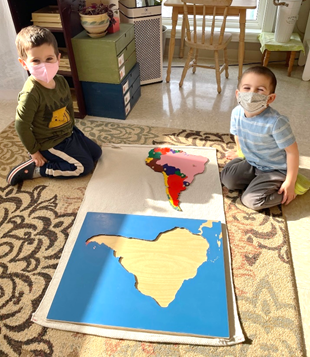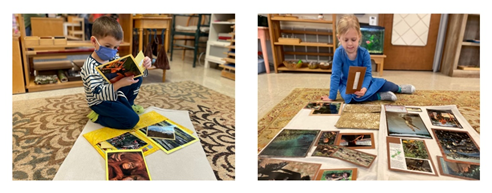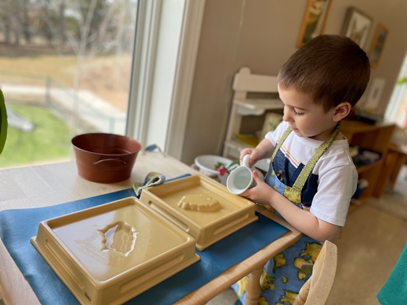Our World – Geography in a Children’s House
Many preschool programs teach children about where they are in the world from the small to the big. For example, they first learn about their town, and then their state, and then their country and so on. In a Montessori Children’s House, we do things differently and start with the whole (the world), and work towards the parts which includes the countries and states and all the culture included in these parts. The first way we introduce the world to the child is through the Globes.
The Sandpaper Globe introduces the child to the idea that the earth is made up of land and water. From there children work with the Painted Globe where they learn that the land is broken up into separate continents, each one painted a different color, and the water is broken up into separate oceans. This provides a young child with a sensorial impression of these concepts.
After that, children are presented the World Puzzle Map, followed by the puzzle maps for each continent. We also have a puzzle map for their country, for our school that is the United States. With these maps the children are learning how the different countries fit together, in a sensorial way.
Sometimes they even like to challenge themselves even more and build the map outside of the frame!
In the beginning, it is just a cool puzzle. Later, based on the child’s interest, we present the names of the continents, countries, or states, and when they have really solidified those names in their mind, we introduce them to how to trace the shapes and to write the names of the continents, countries, or states.
Or they can trace the continents and paint a map of the world!
Another way children learn about our world in the Children’s House is through work with the Cultural Folders. We have one folder for each continent containing photos of art, people, food, traditions, places, and anything related to the culture of that continent. This is a well loved and often used material!
Work with the Land and Water Forms allow the children to explore geography further. With this material, children pour water into the forms, and learn about lakes, islands, peninsulas, gulfs, isthmuses, and straits.
In Children’s House we have a variety of flags from around the world displayed. The children can use these to learn the names of the flags, wave while they walk on the line, or even learn the stories behind the meaning of the design of the flag. When the child is older, they can also learn to draw the flags and to write the name of the countries they belong to.








